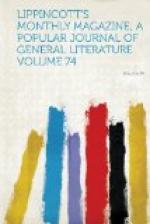[Illustration: FUNERAL PILE FOR THE SECOND KING.]
Among the choice treasures of Siam are her elephants, but they belong exclusively to the Crown, and may be employed only at the royal command. They are used in state processions and in traveling by the king and members of the royal family, and in war at the king’s mandate only. It is death for a Siamese subject, unbidden by his sovereign, to mount one of His Majesty’s elephants. In war they are considered very effective, their immense size and weight alone rendering them exceedingly destructive in trampling down and crushing foot-soldiers. The howdah is placed well up on the animal’s back, and in it sits a military officer of high rank, with an iron helmet on his head, and above him a seven-layered umbrella, as the insignia of his royal commission. On the croup sits the groom, guiding the royal beast with an iron hook, while all about the officer are disposed lances, javelins, pikes, helmets and other munitions of war, which he dispenses as they are needed during the progress of a battle. I have been told that as many as six or seven hundred of these colossal creatures are often marched and marshaled in battle together; and so perfectly are they trained as to be guided and controlled without difficulty, even amid the din of firearms and the conflict of contending armies. Sometimes on the king’s journeys into the interior a train of fifty or sixty will be marched in perfect order, their stately stepping beautiful to behold, but their huge feet coming down with a jolt that threatens to dislocate every joint of the unfortunate rider.
I have spoken of the gorgeousness of the Bangkok temples, but I must not forget to mention the colossal statue of Booddh that reposes in one of them. It is one hundred and seventy feet in length, of solid masonry, perfectly covered with a plating of pure gold, and rests quite naturally upon the right side, the recumbent position indicating the dreamless repose the god now enjoys in nirwana. This is supposed to be the largest image of Gautama, the fourth Booddh, in existence, and it is an object of the profoundest veneration to every devout Booddhist.
Incremation of the dead is the custom in Siam, and while there I was present at several royal funerals, each marked by more lavish display of costly magnificence than we Americans ever see on this side the water. Shortly after I left the country occurred the death of the patriotic second king, so well and favorably known among us as Prince T. Momfanoi, the introducer of square-rigged vessels and many other improvements, and afterward as King Somdet Phra Pawarendr Kamesr Maha Waresr. The body was embalmed, and lay in state for nearly a year before the burning took place. The count de Beauvoir reached Bangkok just in time to see the royal catafalque, of which he gives a somewhat amusing account. He says: “The body, having been thoroughly dried by mercury, was so doubled




